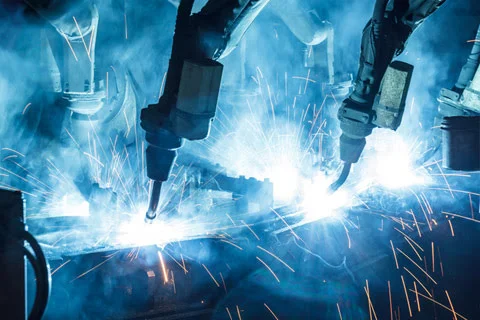Robotic Welding

Welding robotics includes standards that outline safety in regards to welding, welding installations, and other areas.
AWS D16.1M/D16.1:2018
Specification for Robotic Arc Welding Safety
This standard establishes safety requirements with respect to the design, manufacture, maintenance, and operation of arc welding robot systems and ancillary equipment. It also helps to identify and minimize hazards involved in maintaining, operating, integrating, and setting up of arc welding robot systems.
AWS D16.2M/D16.2:2021
Guide for components of robotic and automatic arc welding installations
Guide for Components of Robotic and Automatic Arc Welding Installations, provides performance recommendations for evaluating components of a typical robotic or automatic welding installation. Emphasis is placed on the role of the welding equipment interface. A pin arrangement and specific pin function for each location in a standardized 37-pin connector are proposed.
AWS D16.3M/D16.3:2017
Risk Assessment Guide for Robotic Arc Welding
The purpose of D16.3M/D16.3:2017, Risk Assessment Guide for Robotic Arc Welding, is to identify hazards associated with robotic arc welding. This will help protect personnel. It is not intended to be a guideline for other industrial robotic applications. This guide is intended for persons performing risk assessment and applies to arc welding robots and robot arc welding systems performing the gas metal arc welding (GMAW) or flux cored arc welding (FCAW) process.
AWS D16.4M/D16.4:2015
Specification for the Qualification of Robotic Arc Welding Personnel
This standard provides requirements for the qualification of robotic arc welding personnel.
AWS D16.6M/D16.6:2018
Specification for Robot Arc Welding Training and Testing Cell
AWS D16.6M/D16.6, Specification for Robot Arc Welding Training and Testing Cell, applies to the recommended design, integration, installation, and use of robotic arc welding systems used to train and certify operators and technicians under the AWS Certified Robotic Arc Welding (CRAW) program
AWS QC19-2002
AWS QC19 - Standard for the AWS Certification of Robotic Arc Welding Personnel
This standard defines the certification program for the American Welding Society for use in the Certification of Automated Process Operators and Technicians. These certifications require documentation of experience. satisfactory completion of both written and practical examinations. The examination tests the CRAW's knowledge of welding processes. welding procedures. destructive and non-destructive tests. welding terms. definitions. symbols. reports. safety. quality assurance and responsibilities. robot programming and robot arc welding. and other related subjects. Successful completion of all requirements constitutes the basis for awarding a certification as a Robotic Arc Welding Technician or Robotic Arc Welding Operator.
ISO 6210-1:1991
Cylinders for robot resistance welding guns - Part 1: General requirements
Specifies requirements for geometrical and mechanical characteristics of cylinders and their manufacturing, delivery and test specifications. Gives nominal forces at the piston rod, nominal strokes, and bore diameters.

AWS ARE-11
AWS ARE-11 MECHANIZED. AUTOMATED AND ROBOTIC WELDING
A non-commercial look at the efficiencies of mechanized. automated. and robotic welding. this chapter from the Welding Handbook. Ninth Edition. Volume 1. was written by experts from some of the most successful welding equipment manufacturers and users: Tower Automotive. ABB Flexible Welding Control. KOHOL Systems. Fanuc Robotics-North America. Trek Bicycle Corp.. Johnson Controls. Detroit Center Tool. Panasonic Factory Automation. and The Lincoln Electric Co. Covers system components and operating characteristics for arc and resistance welding. Includes section on "Planning for Automated and Robotic Welding" with emphasis on integration and a sample Gantt chart installation schedule
AWS AWR-95
AWS AWR ARC WELDING WITH ROBOTS: DO'S AND DON'TS *** SET OF 25 PAMPHLETS
This pamphlet is designed to provide the novice as well as the seasoned user of industrial robots with information that can promote and expand successful use of robots in GMAW and FCAW applications. By utilizing robots for arc welding. manufacturing companies can expand the use of welding processes in the manufacture of their products.
